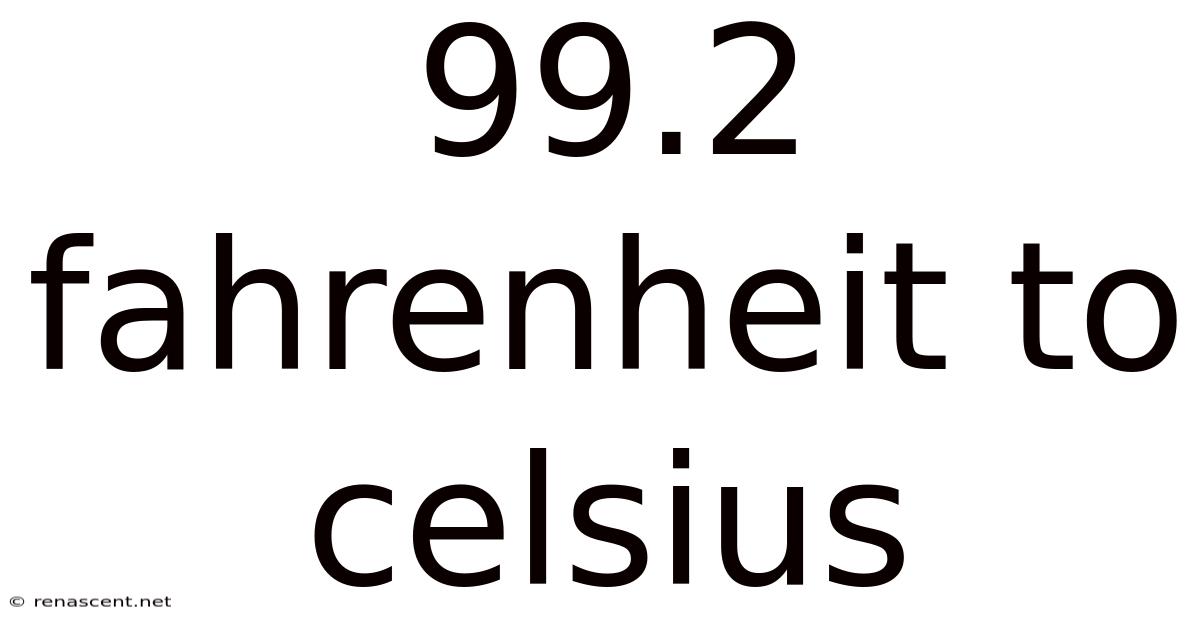99.2 Fahrenheit To Celsius
renascent
Sep 15, 2025 · 5 min read

Table of Contents
Converting 99.2 Fahrenheit to Celsius: A Comprehensive Guide
Are you wondering how to convert 99.2 degrees Fahrenheit to Celsius? This seemingly simple conversion is a fundamental concept in science and everyday life. Understanding temperature conversions is crucial for various applications, from cooking and medicine to meteorology and engineering. This comprehensive guide will not only show you how to convert 99.2°F to °C but will also delve into the underlying principles, provide practical examples, and address frequently asked questions. We’ll explore the history of these temperature scales, their differences, and the importance of accurate conversions.
Understanding Fahrenheit and Celsius Scales
Before jumping into the conversion, let's clarify the differences between the Fahrenheit (°F) and Celsius (°C) scales. Both are used to measure temperature, but they have different origins and reference points.
-
Fahrenheit: This scale, developed by Daniel Gabriel Fahrenheit in the early 18th century, uses the freezing point of water as 32°F and the boiling point of water as 212°F, with 180 degrees separating them. This scale is primarily used in the United States and a few other countries.
-
Celsius: Also known as the centigrade scale, Celsius was developed by Anders Celsius in the mid-18th century. It sets the freezing point of water at 0°C and the boiling point at 100°C, with 100 degrees separating them. This is the most widely used temperature scale globally and is preferred in scientific contexts.
The Conversion Formula: From Fahrenheit to Celsius
The formula to convert Fahrenheit (°F) to Celsius (°C) is:
°C = (°F - 32) × 5/9
This formula essentially takes the Fahrenheit temperature, subtracts 32 (to adjust for the difference in freezing points), and then multiplies by 5/9 (to account for the different degree increments).
Converting 99.2°F to °C: A Step-by-Step Guide
Let's apply this formula to convert 99.2°F to Celsius:
-
Start with the Fahrenheit temperature: 99.2°F
-
Subtract 32: 99.2 - 32 = 67.2
-
Multiply by 5/9: 67.2 × 5/9 = 37.333...
-
Round to the desired precision: Rounding to one decimal place, we get 37.3°C.
Therefore, 99.2°F is equivalent to 37.3°C.
Practical Applications and Interpretations of 37.3°C
A temperature of 37.3°C is significant in several contexts:
-
Human Body Temperature: A normal human body temperature is generally considered to be around 37°C (98.6°F). 99.2°F (37.3°C) indicates a slightly elevated temperature, often considered a low-grade fever. This warrants monitoring and may require consulting a medical professional, depending on other symptoms.
-
Environmental Conditions: 37.3°C is a warm temperature, considered comfortably warm to many people. However, it can be quite hot and uncomfortable in humid environments. This temperature is relevant for considerations in various fields, including agriculture, manufacturing, and climate control.
-
Scientific Experiments: In scientific settings, accuracy is paramount. The precise conversion of 99.2°F to 37.3°C is essential for accurate recording and analysis of experimental data.
The Importance of Accurate Temperature Conversions
Accurate temperature conversions are crucial for several reasons:
-
Medical Diagnosis and Treatment: Inaccurate temperature readings can lead to misdiagnosis and improper treatment. Precise conversions are vital in monitoring patient health and administering appropriate medication.
-
Industrial Processes: Many industrial processes, such as manufacturing and food processing, require precise temperature control. Inaccurate conversions can result in product defects or safety hazards.
-
Scientific Research: In scientific experiments, accurate temperature measurements are critical for reliable and reproducible results. Inaccurate conversions can lead to flawed conclusions and invalid research findings.
-
Meteorology and Climate Studies: Accurate temperature conversions are essential for recording and analyzing weather patterns, climate change, and forecasting.
Beyond the Formula: Understanding the Underlying Principles
While the formula provides a straightforward method for conversion, understanding the underlying principles enhances comprehension. The conversion factor 5/9 reflects the different sizes of the degrees in the two scales. The Celsius scale has 100 degrees between the freezing and boiling points of water, while the Fahrenheit scale has 180 degrees. Therefore, each degree Celsius is larger than a degree Fahrenheit by a factor of 9/5 or 1.8. Subtracting 32 adjusts for the different zero points of the two scales.
Frequently Asked Questions (FAQ)
Q: Are there online calculators for Fahrenheit to Celsius conversions?
A: Yes, numerous online calculators are available for quick conversions. These are helpful tools for quick calculations but understanding the underlying formula is beneficial for deeper comprehension.
Q: Can I convert Celsius to Fahrenheit using a similar formula?
A: Yes, the reverse conversion formula is: °F = (°C × 9/5) + 32
Q: What are some common mistakes to avoid when converting temperatures?
A: Common mistakes include incorrectly applying the order of operations (PEMDAS/BODMAS) in the formula, and using the wrong conversion factor. Double-checking your calculations and ensuring you're using the correct formula can prevent errors.
Q: Why are there two different temperature scales?
A: Different temperature scales emerged historically due to different scientific and practical considerations. While Celsius is now the globally preferred scale for scientific purposes, Fahrenheit remains in common use in some countries due to historical reasons and established practices.
Conclusion: Mastering Temperature Conversions
Converting 99.2°F to 37.3°C is more than just a simple calculation; it's a demonstration of understanding fundamental principles in thermometry. This process highlights the importance of accurate conversions in various fields, from healthcare and manufacturing to scientific research and everyday life. By grasping the conversion formula and the underlying principles, you can confidently navigate temperature conversions and apply this knowledge in various contexts. The ability to perform these conversions accurately improves comprehension and enhances problem-solving skills in many scientific and practical scenarios. Remember to always double-check your calculations and consider the context of the temperature to ensure accurate interpretation and application.
Latest Posts
Related Post
Thank you for visiting our website which covers about 99.2 Fahrenheit To Celsius . We hope the information provided has been useful to you. Feel free to contact us if you have any questions or need further assistance. See you next time and don't miss to bookmark.